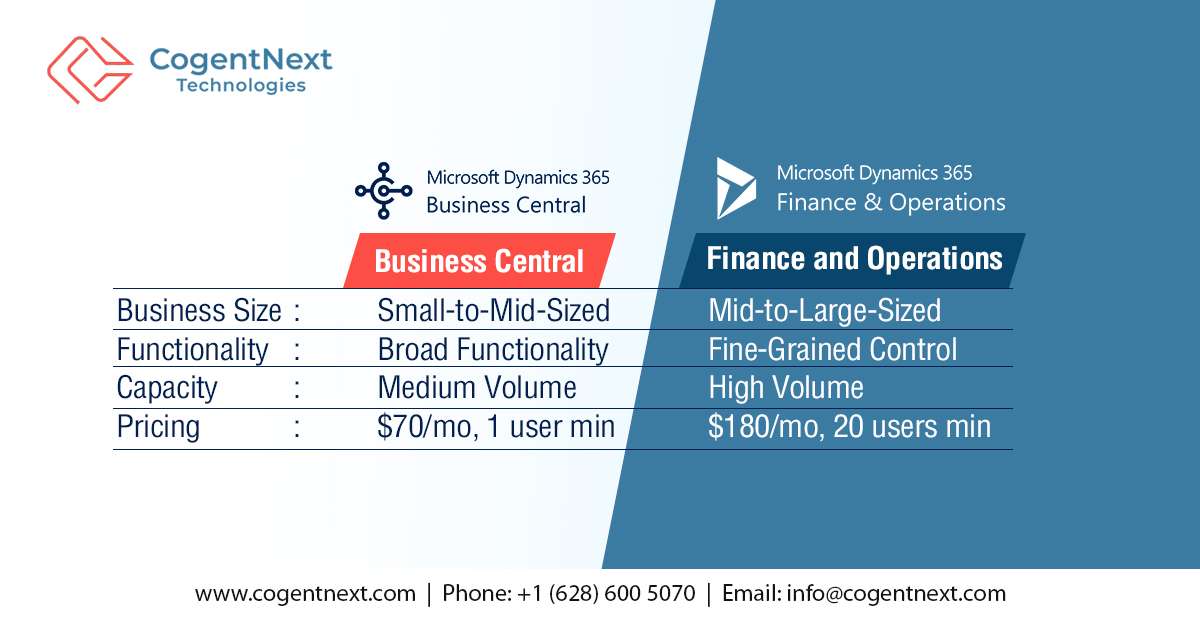
Business Central vs. Finance and Supply Chain Management – Which One Is Right For You?
When it comes to choosing the right cloud ERP solution for your organization, the decision between Dynamics 365 Business Central vs. Finance is crucial. Cloud ERP is the future, and Microsoft has doubled down on it, literally! They have, not one, but two powerful ERP solutions that can be deployed on-premises but are native to the cloud. This allows Microsoft technology, including Business Central vs. Finance, to be available to a broader range of business and enterprise customers. In this article, I’ll highlight the differences between Dynamics 365 Business Central and Dynamics 365 Finance and help you see which solution will best fulfill your needs – now and in the future.
A Look at Business Central vs. Finance
Dynamics 365 Business Central has its roots in Dynamics NAV, a previous on-premises solution. Taking that solid platform and extending it with cloud functionality and many new, advanced features – such as machine learning, powerful reporting and visualizations with Microsoft Power BI, and tight integration with Microsoft 365 – makes it an excellent choice for many small- to medium-sized enterprises (SMEs).
Features. Business Central fits the mid-market segment like a glove, providing a broad range of functionality while avoiding an endless feature and customization list that can prove overwhelming for organizations that simply don’t need it. Don’t mistake it for a simple solution, however. Here’s a sampling of what it has to offer:
- Financial Management
- Inventory Management
- Customer Relationship Management (CRM)
- Purchasing
- Order Management
- Project Management
Even the Wholesale Distribution and Manufacturing industries have support built in. Granted, Business Central offers features for the more traditional business processes of these segments; advanced functionality, such as for process and mixed-mode manufacturing, is available via add-ons, or in the more robust Finance and Supply Chain Management solution.
Capacity. Some feel that Business Central can support only low numbers of users. Many organizations have implemented it with 200, 300, or even more users, processing thousands, even tens of thousands of transactions per month.
However, the system does have limits. If your organization is performing hundreds of thousands of transactions each month, the more powerful Finance and Supply Chain Management solutions would better meet your needs.
Pricing. Business Central is not only one of the most powerful mid-market ERP solutions out there, but it’s also one of the most affordable. With licenses starting at $70 per month, per user, with a one-user minimum, it has a low barrier to entry. What is more, with its straightforward approach to configuration and implementation, partner costs are lower, making it a good fit for small-but-growing companies to get a fast return on investment for their ERP solution.
An Overview of Finance and Supply Chain Management
Commonly called Dynamics 365 Finance and Operations (F&O), the solution was recently rebranded by Microsoft as Dynamics 365 Finance and Supply Chain Management, further separating functionality into modules and allowing mid- to large-scale enterprises to select and implement the parts they need without the parts they don’t. It was born from the former Dynamics AX, drawing on its long history in the enterprise market and bringing that power to a cloud-native solution. And of course, it has tight hooks into other Microsoft Business Applications, such as the Power Platform and Microsoft 365.
Features. Finance and Supply Chain Management is the most powerful and comprehensive solution Microsoft offers. Here are a few of the powerful features that set it apart from Business Central:
- International inter-company trading
- Financial compliance (Country localizations available)
- Product and vendor management
- Quality management
- Inter-company stock transfers
- Transportation management
- Manufacturing – process or mixed-mode manufacturing
For companies that have far-flung operations in multiple countries that need to ensure compliance in varying jurisdictions, and for more fine-grained control over business and manufacturing processes, Finance and Supply Chain Management is your ticket to success.
Capacity. Designed to handle hundreds of thousands of transactions per month, Finance and Supply Chain Management has the muscle needed for even the largest companies. It has a generous storage capacity that grows as you add users, ensuring you have all you need.
Pricing. Naturally, Finance and Supply Chain Management are more costly, but with the increased investment, you gain many times over in depth of functionality and power. Starting at $180 per month per user, it requires a minimum of 20 users to get started. Because of the advanced capabilities, it also has a longer implementation time, but it results in a system custom-tailored to your needs.
Ready to Choose?

As you can see, both of Microsoft’s Cloud ERP offerings are fantastic solutions that cover the needs of the mid-market and enterprise segments very well. Where do you fit in?
At CogentNext, we’re interested in seeing you succeed, and that starts from the moment you decided to evaluate your ERP options. We can guide you through the process, helping to analyze your current business operations and map them to the solution best capable of meeting those needs with room to grow.
What is more, we help you through the implementation and training phases, resulting in broad user adoption and a greater chance of full success and rapid return on investment. Would you like a helping hand to make your project a success?
Contact us today to learn how we can make the process an easy transition for you.
By Chandra Subramanian, CogentNext Technologies
